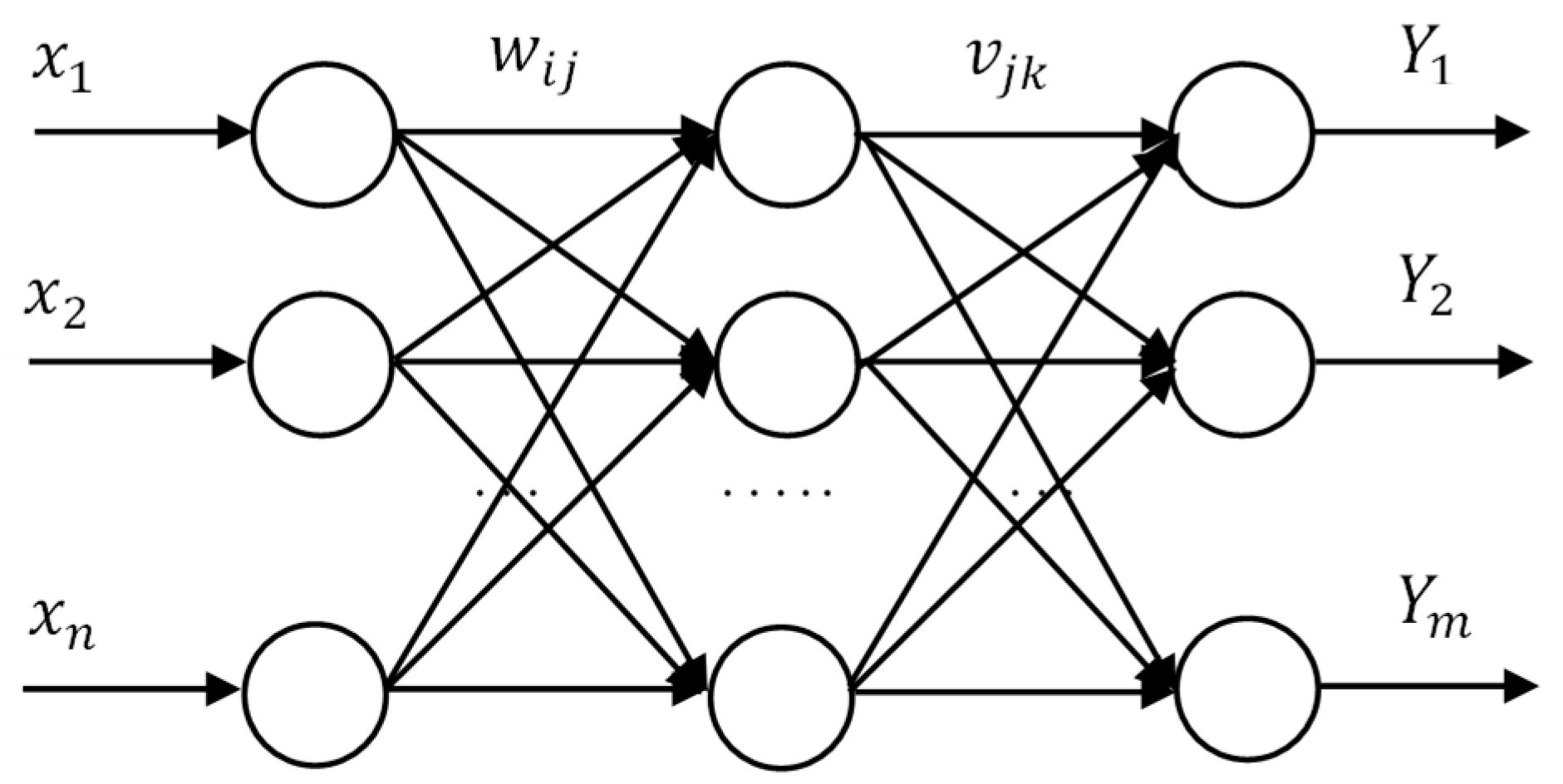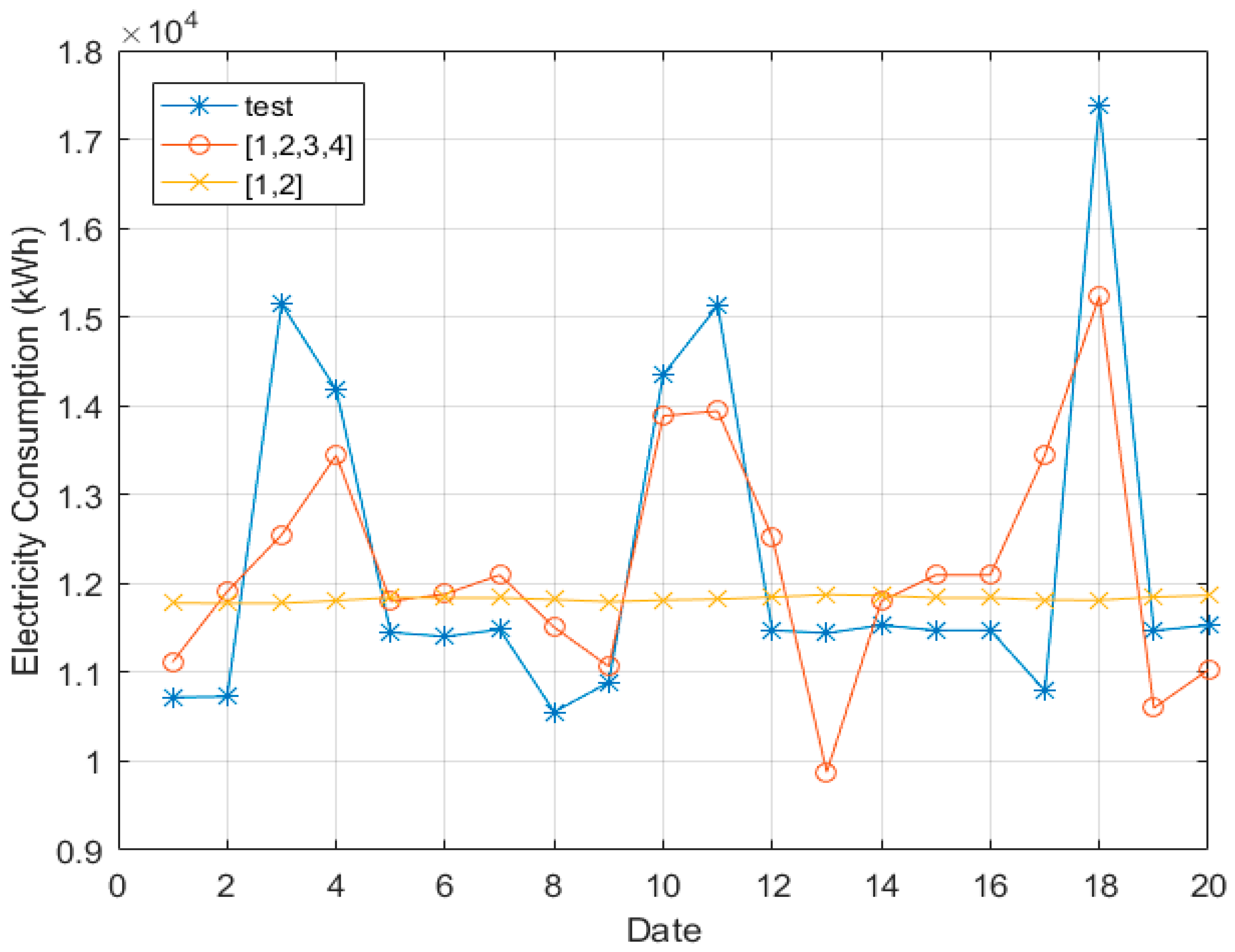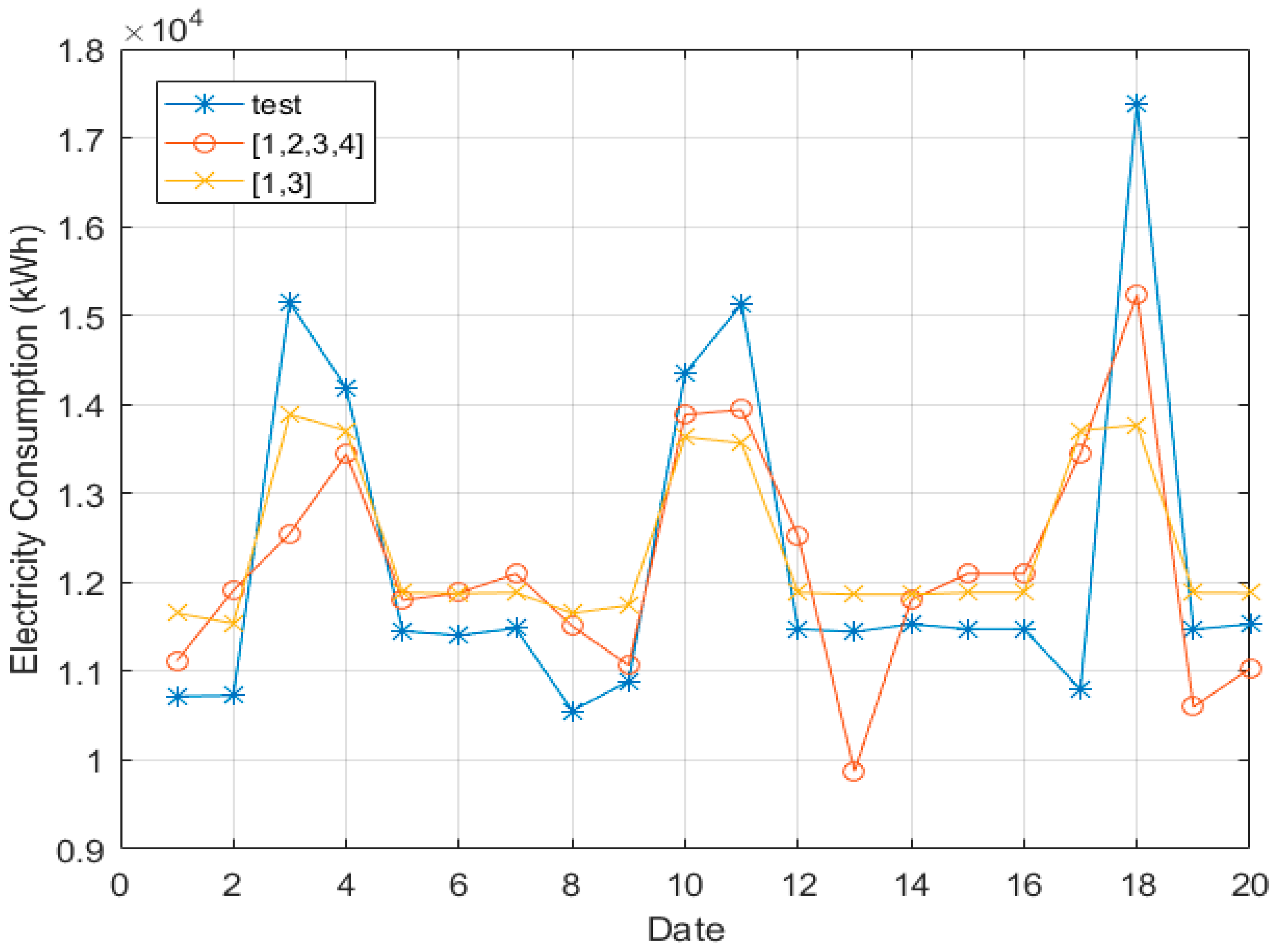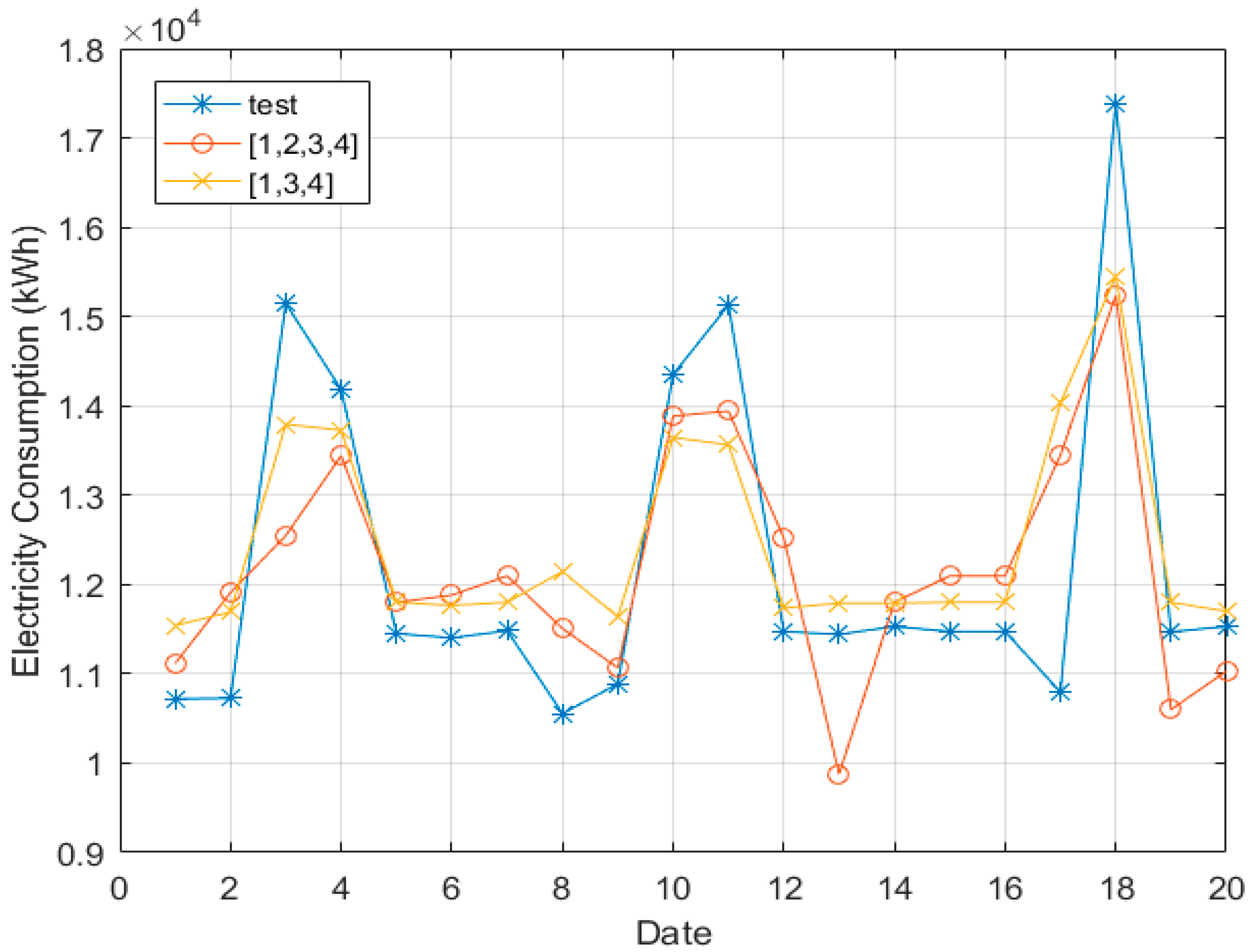Simplified Neural Network Model Design with Sensitivity Analysis and Electricity Consumption Prediction in a Commercial Building
Abstract
1. Introduction
2. Sensitivity in Neural Network
2.1. Sensitivity Analysis
2.2. Sensitivity Application to Neural Network
2.2.1. Perturbation Relation between Input and Output
2.2.2. Least Square Error
3. Simplified Model Construction
3.1. Input–Output Relationship
- Train the network with data set M, and get test result and assign as R1.
- Add a certain proportion, such as p%, into the input data, and make the intended input data set N. Train and get test result as R2.
- Calculate the difference R1 and R2, which is called MIV.
- {1, 2, 3, 4} = temperature, humidity ratio, working day, weather characteristics
- {1, 3} = temperature, working day
- {1, 2} = temperature, humidity
- {2, 4} = humidity, weather characteristics
- {3, 4} =working day, weather characteristics
- {1, 2, 3} = temperature, humidity ratio, working day
- {1, 2, 4} = temperature, humidity ratio, weather characteristics
- {1, 3, 4} = temperature, working day, weather characteristics
3.2. Bayesian Regularized Neural Network
4. Discussion
- Simulate full input {1, 2, 3, 4} and two inputs {1, 2}. Compare with actual test data.
- Simulate full input {1, 2, 3, 4} and two inputs {1, 3}. Compare with actual test data.
- Simulate full input {1, 2, 3, 4} and three inputs {1, 3, 4}. Compare with actual test data.
5. Conclusions
Author Contributions
Funding
Acknowledgments
Conflicts of Interest
Appendix A
| Date | Temperature (°C) | Humidity (%) | Working Day | Weather Characteristics | Electricity Consumption (kWh) |
|---|---|---|---|---|---|
| 03.01 | 5 | 42 | 0 | 0.8 | 13958 |
| 03.02 | 6 | 31 | 0 | 1 | 13529 |
| 03.03 | 6 | 46 | 1 | 0.8 | 9148 |
| 03.04 | 4 | 78 | 1 | 0.6 | 12071 |
| 03.05 | 3 | 46 | 1 | 1 | 7711 |
| 03.06 | 5 | 33 | 1 | 1 | 8734 |
| 03.07 | 4 | 29 | 1 | 1 | 8748 |
| … | … | … | … | … | … |
| 04.24 | 20 | 30 | 1 | 1 | 11473 |
| 04.25 | 20 | 30 | 1 | 1 | 11473 |
| 04.26 | 16 | 57 | 0 | 0.7 | 10795 |
| 04.27 | 15 | 68 | 0 | 0.5 | 17385 |
| 04.28 | 20 | 39 | 1 | 1 | 11470 |
| 04.29 | 21 | 46 | 1 | 0.8 | 11531 |
Appendix B
References
- Administration, N.E. National Energy Administration in China. 2015. Available online: http://www.nea.gov.cn/2016-01/15/c_135013789.htm (accessed on 1 December 2018).
- Xie, Q.; Ouyang, H.; Gao, X. Estimation of electricity demand in the residential buildings of China based on household survey data. Int. J. Hydrog. Energy 2016, 41, 15879–15886. [Google Scholar] [CrossRef]
- Carli, R.; Dotoli, M.; Pellegrino, R.; Ranieri, L. A decision making technique to optimize a building stock energy efficiency. IEEE Trans. Syst. Man Cybern. Syst. 2017, 47, 794–807. [Google Scholar] [CrossRef]
- Pacheco-Torres, R.; Heo, Y.; Choudhary, R. Efficient energy modelling of heterogeneous building portfolios. Sustain. Cities Soc. 2016, 27, 49–64. [Google Scholar] [CrossRef]
- Carli, R.; Dotoli, M.; Pellegrino, R. A Hierarchical Decision Making Strategy for the Energy Management of Smart Cities. IEEE Trans. Autom. Sci. Eng. 2017, 14, 505–523. [Google Scholar] [CrossRef]
- Dall’O’, G.; Norese, M.F.; Galante, A.; Novello, C. A Multi-Criteria Methodology to Support Public Administration Decision Making Concerning Sustainable Energy Action Plans. Energies 2013, 6, 4308–4330. [Google Scholar] [CrossRef]
- Carli, R.; Dotoli, M. Energy scheduling of a smart home under nonlinear pricing. In Proceedings of the 2014 IEEE 53rd Conference on Decision and Control (CDC), Los Angeles, CA, USA, 15–17 December 2014; pp. 5648–5653. [Google Scholar]
- Ahmad, M.W.; Mourshed, M.; Rezgui, Y. Trees vs. Neurons: Comparison between random forest and ANN for high-resolution prediction of building energy consumption. Energy Build. 2017, 147 (Suppl. C), 77–89. [Google Scholar] [CrossRef]
- Ahmad, M.W.; Mourshed, M.; Yuce, B.; Rezgui, Y. Computational intelligence techniques for HVAC systems: A review. Build. Simul. 2016, 9, 359–398. [Google Scholar] [CrossRef]
- Hsu, D. Comparison of integrated clustering methods for accurate and stable prediction of building energy consumption data. Appl. Energy 2015, 160 (Suppl. C), 153–163. [Google Scholar] [CrossRef]
- Shi, G.; Liu, D.; Wei, Q. Energy consumption prediction of office buildings based on echo state networks. Neurocomputing 2016, 216 (Suppl. C), 478–488. [Google Scholar] [CrossRef]
- Tetlow, R.M.; van Dronkelaar, C.; Beaman, C.P.; Elmualim, A.A.; Couling, K. Identifying behavioural predictors of small power electricity consumption in office buildings. Build. Environ. 2015, 92 (Suppl. C), 75–85. [Google Scholar] [CrossRef]
- Ye, Z.; Kim, M.K. Predicting electricity consumption in a building using an optimized backpropagation and Levenberg-Marquardt back-propagation neural network: Case study of a shopping mall in China. Sustain. Cities Soc. 2018, 42, 176–183. [Google Scholar] [CrossRef]
- Neto, A.H.; Fiorelli, F.A.S. Comparison between detailed model simulation and artificial neural network for forecasting building energy consumption. Energy Build. 2008, 40, 2169–2176. [Google Scholar] [CrossRef]
- Werbos, P. Beyond Regression: New Tools for Prediction and Analysis in the Behavioral Sciences. Ph.D. Thesis, Harvard University, Cambridge, MA, USA, 1975. [Google Scholar]
- Azadeh, A.; Ghaderi, S.F.; Sohrabkhani, S. Annual electricity consumption forecasting by neural network in high energy consuming industrial sectors. Energy Convers. Manag. 2008, 49, 2272–2278. [Google Scholar] [CrossRef]
- Zhong, B.; Lu, K.; Lv, D.; Luo, J.; Fang, X. Short-term Prediction of Building Energy Consumption Based on GALM Neural Network. In Proceedings of the International Conference on Advances in Mechanical Engineering and Industrial Informatics, Zhengzhou, China, 11–12 April 2015. [Google Scholar]
- Ekici, B.B.; Aksoy, U.T. Prediction of building energy consumption by using artificial neural networks. Adv. Eng. Softw. 2009, 40, 356–362. [Google Scholar] [CrossRef]
- Kumar, R.; Aggarwal, R.K.; Sharma, J.D. Energy analysis of a building using artificial neural network: A review. Energy Build. 2013, 65, 352–358. [Google Scholar] [CrossRef]
- Doyle, J.C.; Francis, B.A.; Tannembaum, A.R. Feedback Control Theory; Macmillan Publishing Company: London, UK, 1992. [Google Scholar]
- Hashem, S. Sensitivity analysis for feedforward artificial neural networks with differentiable activation functions. In Proceedings of the IJCNN 92, Baltimore, MD, USA, 7–11 June 1992; Volume 1, pp. 419–424. [Google Scholar]
- Fu, L.; Chen, R. Sensitivity analysis for input vector in multilayer feedforward neural network. In Proceedings of the IEEE International Conference Neural Networks, San Francisco, CA, USA, 28 March–1 April 1993; Volume 1, pp. 215–218. [Google Scholar]
- Choi, J.Y.; Choi, C.H. Sensitivity analysis of multilayer perceptron with differentiable activation functions. IEEE Trans. Neural Netw. 1992, 3, 101–107. [Google Scholar] [CrossRef] [PubMed]
- Zeng, X.; Yeung, D.S. Sensitivity analysis of multilayer perceptron to input and weight perturbations. IEEE Trans. Neural Netw. 2001, 12, 1358–1366. [Google Scholar] [CrossRef] [PubMed]
- Foresee, F.D.; Hagan, M.T. Gauss-Newton approximation to Bayesian learning. In Proceedings of the 1997 International Joint Conference on Neural Networks, Houston, TX, USA, 12 June 1997; pp. 1930–1935. [Google Scholar]
- Saltelli, A.; Tarantola, S.; Campolongo, F. Sensitivity analysis as an ingredient of modelling. Stat. Sci. 2000, 15, 377–395. [Google Scholar]
- Dorato, P. (Ed.) Robust Control; IEEE Press: Piscataway, NJ, USA, 1987. [Google Scholar]
- Cucchiella, F.; D’Adamo, I.; Gastaldi, M. Economic Analysis of a Photovoltaic Systems: A Resource for Residential Households. Energies 2017, 10, 814. [Google Scholar] [CrossRef]
- Biserni, C.; Valdiserri, P.; D’Orazio, D.; Garai, M. Energy Retrofitting Strategies and Economic Assessment: The Case Study of Residential Complex Using Utility Bills. Energies 2018, 11, 2055. [Google Scholar] [CrossRef]
- Wong, S.L.; Wan, K.K.W.; Lam, T.N.T. Artificial neural networks for energy analysis of office buildings with daylighting. Appl. Energy 2010, 87, 551–557. [Google Scholar] [CrossRef]
- Liu, Z.P. Research and Design of Wireless Monitoring System for Building Energy Consumption. Master’s Thesis, Dalian University of Technology, Dalian, China, 2015. (In Chinese). [Google Scholar]
- Zhang, Z.; Jin, X. Prediction of peak velocity of blasting vibration based on artificial Neural Network optimized by dimensionality reduction of FA-MIV. Math. Probl. Eng. 2018, 2018, 8473547. [Google Scholar] [CrossRef]
- MacKay, D.J.C. A practical Bayesian framework for backpropagation networks. Neural Comput. 1992, 4, 448–472. [Google Scholar] [CrossRef]
- MacKay, D.J.C. Bayesian Interpolation. Neural Comput. 1992, 4, 415–447. [Google Scholar] [CrossRef]
- Bishop, V.M. Neural Networks for Pattern Recognition; Oxford University Press: Oxford, UK, 1995. [Google Scholar]





| Temperature | Humidity | Working Day | Weather Characteristics | Wind Speed | |
|---|---|---|---|---|---|
| MIV | 2.5% | 1.51% | 2.7% | −1.64% | −0.09% |
| Temperature (°C) | Humidity (%) | Working Day | Weather Characteristics | |
|---|---|---|---|---|
| Index | 1 | 2 | 3 | 4 |
| Set of Inputs | Mean of RMSE (Training) | Std of RMSE (Training) | Mean of RMSE (Test) | Std of RMSE (Test) |
|---|---|---|---|---|
| {1,2,3,4} | 223.6069 | 0.00084 | 5342.2 | 443.7662 |
| {1,2} | 878.4060 | 0.0063 | 70538 | 52.7916 |
| {1,3} | 630.3841 | 0.0056 | 2291.9 | 469.5288 |
| {1,3,4} | 370.6076 | 0.0059 | 12019 | 2106.9 |
| Set of Inputs | Mean of RMSE (Training) | Std of RMSE (Training) | Mean of RMSE (Test) | Std of RMSE (Test) |
|---|---|---|---|---|
| {1,2,3,4} | 571.6877 | 3.4278 × 10−13 | 1168.5 | 1.3711 × 10−12 |
| {1,2} | 1855.1 | 6.8556 × 10−13 | 1924.2 | 3.1993 × 10−12 |
| {1,3} | 850.3912 | 1.1426 × 10−13 | 1255.2 | 3.1993 × 10−12 |
| {1,4} | 1739.9 | 1.5996 × 10−12 | 1800 | 3.6563 × 10−12 |
| {2,3} | 1204.6 | 0.0048 | 1236.7 | 0.0367 |
| {2,4} | 1869.2 | 2.7422 × 10−12 | 1907.6 | 3.1993 × 10−12 |
| {3,4} | 1119.3 | 0.0015 | 1267.5 | 0.1580 |
| {1,2,3} | 550.2780 | 4.5704 × 10−13 | 1330.8 | 2.2852 × 10−12 |
| {1,2,4} | 1888.6 | 1.3711 × 10−12 | 1940.6 | 1.5996 × 10−12 |
| {1,3,4} | 609.8934 | 0.0125 | 1120.3 | 0.1132 |
© 2019 by the authors. Licensee MDPI, Basel, Switzerland. This article is an open access article distributed under the terms and conditions of the Creative Commons Attribution (CC BY) license (http://creativecommons.org/licenses/by/4.0/).
Share and Cite
Kim, M.K.; Cha, J.; Lee, E.; Pham, V.H.; Lee, S.; Theera-Umpon, N. Simplified Neural Network Model Design with Sensitivity Analysis and Electricity Consumption Prediction in a Commercial Building. Energies 2019, 12, 1201. https://doi.org/10.3390/en12071201
Kim MK, Cha J, Lee E, Pham VH, Lee S, Theera-Umpon N. Simplified Neural Network Model Design with Sensitivity Analysis and Electricity Consumption Prediction in a Commercial Building. Energies. 2019; 12(7):1201. https://doi.org/10.3390/en12071201
Chicago/Turabian StyleKim, Moon Keun, Jaehoon Cha, Eunmi Lee, Van Huy Pham, Sanghyuk Lee, and Nipon Theera-Umpon. 2019. "Simplified Neural Network Model Design with Sensitivity Analysis and Electricity Consumption Prediction in a Commercial Building" Energies 12, no. 7: 1201. https://doi.org/10.3390/en12071201
APA StyleKim, M. K., Cha, J., Lee, E., Pham, V. H., Lee, S., & Theera-Umpon, N. (2019). Simplified Neural Network Model Design with Sensitivity Analysis and Electricity Consumption Prediction in a Commercial Building. Energies, 12(7), 1201. https://doi.org/10.3390/en12071201





